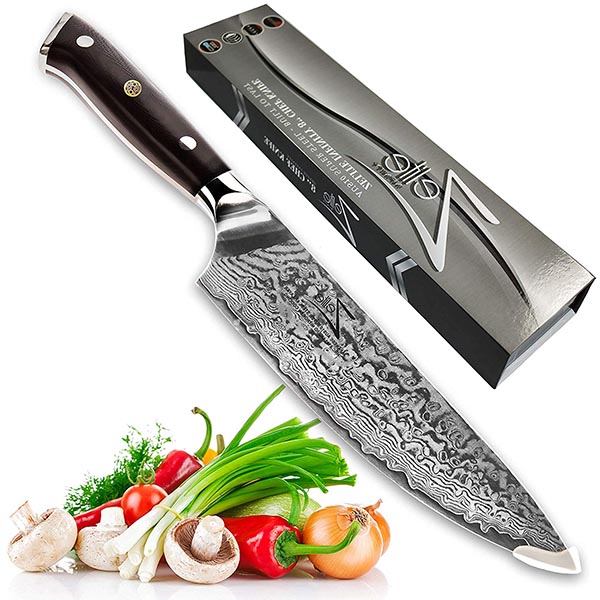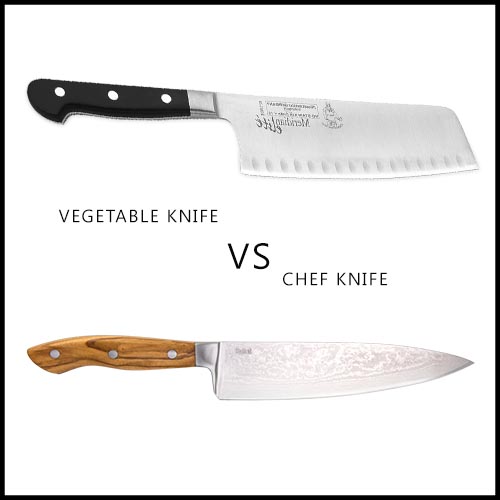Choose your next knife carefully, and it will save you hundreds of dollars down the line.
When it comes to the most versatile kitchen knives, you wouldn’t settle for something just okay, right? You would look for quality, excellence, and guaranteed performance.
Nothing beats a multipurpose chef knife for its indispensability in the kitchen.
We’ve listed three of our favorite models here—some of the best you can find on the market today.
Choose your bet wisely by reading this buyer’s guide, first.
In a hurry? Check our top picks!
| Model | Description |
|---|---|
| ZELITE INFINITY Chef Knife | Our premium pick for both experienced and budding chefs. |
| Shun DM0706 Classic Chef Knife | Best for experienced chefs. |
| Imarku Pro Kitchen 8 Inch Chef's Knife | Most popular budget options |
Table of Contents
Buyer’s guide to choose a chef knife
German VS Gyuto
Gyuto chef knife
- More suitable for push-and-pull motion of cutting.
- If you want a sharper tip, you can choose this knife.
- It has a flatter belly than the German knife, allowing you to have more control.
- You can easily sharpen the blades, as Gyuto knives don’t have full bolsters that extend to the edge.
- Since high- carbon steel blades are thinner, they have acute bevel angles.
- They stay sharp longer than German knives, given that you maintain them regularly.
German chef knife
- More suitable for rocking motion of cutting.
- These are also heavier, having full bolsters that extend to the edge.
- With an even bevel, they don’t develop chips easily; however, they tend to lose their edge quickly.
- German knives have thicker blades, making them ideal for heavy-duty tasks that involve cutting bones or tough cartilages.
Size and Weight
Size
Your choice of size basically depends on your preference. However, the ideal size is 8 inches, both for home cooks and experts. Still, you can choose anywhere from 6 to 14 inches.
Weight
Like size, choosing the right weight for a knife can be subjective.
Do you want to cut through tough flesh? You might want to use a heavier knife, as it can fall heavily and cut the meat right away.
Alternatively, you might want a lighter knife if you move fast and use knives for longer periods.
The ideal chef knife weighs a little over 7 ounces.
Balance and Comfort
Balance
You can test a knife’s balance by gripping its handle.
Either of the handle and the blade shouldn’t be heavier than the other. If the grip feels awkward, then it’s not worth it.
Comfort
Maximum comfort is achieved when you feel like your hand and the knife are one.
A knife should also have a knuckle clearance. Nothing can be peskier than your knuckles repeatedly bumping into the wooden board!
Full Tang or Partial Tang
It’s always better to choose a full tang blade, as it provides more balance to the knife. Also, with a full tang, you can put more force through the handle against any tough meat or bones.
Stainless Steel VS High-Carbon Stainless Steel VS Carbon Steel
Stainless Steel
Stainless steel knives are what you can call “second options”. They are next to the carbon steel knives in almost everything. Their only aces against carbon steel knives are durability and rust resistance.
Carbon Steel
Carbon steel knives are miles better than stainless steel knives. They’re also sharper than the latter. You should only worry about their high demand for maintenance.
High-Carbon Stainless Steel
Needless to say, these knives have the best of both worlds. They mop the floor when it comes to edge retention, balance, comfort, and, of course, sharpness. Most of these knives are also forged, which guarantees excellent-quality steel blades.
Superstar brands of chef’s knives you will love
1. ZELITE INFINITY Chef Knife 8 Inch – Alpha-Royal Series – Our premium pick for chefs

- 8” Gyuto chef knife
- 9.9 ounces
- Black color
- Mirror polished cutting angle
- 12-degree pro razor edge per side
- 67-layer high carbon stainless steel
- Rockwell hardness HRC61
Product Description
This premium chef knife boasts of excellent function and form in every inch.
It has beautiful intricate details etched on its blade. Its highly thoughtful handle will please seasoned chefs and home cooks.
Every glide through meats, fruit slices, or greens left us with gasps. Breathtaking knife, really.
It’s one of the best kitchen knives for the money that you will not regret buying.
- Forged full tang
- Visually stunning blade
- Excellent build quality and precision
- A handle with smooth tactile quality
- No blemishes or chips, guaranteed flawless
- Ideal for any meat, fish, or vegetable cutting
- Beautiful VG10 Super Steel 67-layer Damascus blade
- Cuts turkey meat, fruits, vegetables, and bread
- Crafted using the traditional 3-Step Honbazuke method
- Has traditional Asian features, but has the Western heft and feel
- Ergonomic rounded, top military grade G10 triple-riveted handle
- No sheath
- Not suitable for dishwashers
Why should you buy this product?
If you want incredible quality for the long run, you should stick to the Zelite Infinity’s Alpha-Royal Series model.
Definitely our premium choice—price, features, and quality-wise.
It’s the one to beat.
With this piece, you will be buying for quality, comfort, and balance. Most importantly, the sharpness—this high-carbon stainless steel knife will help you cut uniform vegetables and dice beautiful marbled beef.
What we love the most is the specially designed handle. With its grip and balance, we instantly knew this knife is for long-term use.
2. Shun DM0706 Classic 8-Inch Chef’s Knife – Best for experienced chefs

- 8 inches
- Black color
- 7.13 ounces
- Double-beveled edge
- Rockwell hardness rating of 60-61
- Black laminated PakkaWood handle
- Hand-sharpened 16° double-bevel blade
- VG-10, 32-layer high-carbon stainless steel
Product Description
The Shun chef’s knife is the classic, high-performing knife as you know it. But don’t get it twisted—classic doesn’t equate to plain and predictable.
At 7.13 ounces, this knife is lightweight, minimalist and treat filled with premium features.
It’s easily one of those best chef knives we have confirmed by only trying it once.
With a feature-packed commercial design, this knife will fill the hearts of seasoned chefs with joy.
- Dishwasher-safe
- Highly resistant to rust
- It has knuckle clearance
- Ergonomic D-shaped handle that fits most hand sizes
- Handle is NSF certified for use in commercial kitchens
- Has microscopic air pockets that minimize friction when slicing
- With a 16-degree angle, it’s sharper than most Western 22-degree angle knives
- Features Japanese super steel high-carbon VG-10, famous for great edge retention
- Users must immediately prevent water from sitting on the blade
- Not suitable for chefs who like knives with intricate details
Why should you buy this product?
Most experts advise chefs to work with what they know. And, if you agree with this, this classic model by Shun should be your choice.
It’s exactly what we expected from a premium chef’s knife—classic design, excellent high-carbon steel blade, and elegant handle certified for commercial kitchen use.
If you’re one of those hardened superior chefs who hate gimmicks, the Shun chef’s knife will be your best buddy.
Who says familiarity always breeds contempt? Not with this knife. It’s reliable, classic, and sharp.
3. Imarku Pro Kitchen 8 Inch Chef’s Knife – Most Popular Budget Option

- 8-inch knife
- 16 ounces
- 16-18% chrome
- 2.3 mm thick blade
- High-carbon stainless steel blade
- Rockwell Hardness Scale of 56-58
- Ergonomic pakkawood handle
Product Description
This chef’s knife by Imarku Pro Kitchen is revered for its strength and sharpness. It’s no surprise, given that it’s crafted using German engineering techniques.
On top of that, the handle’s rounded shape is gentle for the hands, so it’s ideal for long periods of cutting.
It iss truly designed for busy professionals.
- Dishwasher-safe
- Anti-tarnish, stain-resistant blade
- Anti-fatigue, anti-slip handle from Africa
- Elegant, glossy appeal because of the chrome finish
- Added toughness, with its blade having 0.6-0.75 carbon
- Has a tight package
- Logo starts to fade eventually
- Not suitable for slicing frozen foods
Why should you buy this product?
Although we can’t say it’s the best, this visually striking chef’s knife attracts and pleases a lot of people. In fact, it’s the best-selling Gyutou knife on Amazon.
We love its lightweight, sharp blade. If you have a limited budget, but still want a reliable knife, this is your best choice.
Surely, this model will meet any budding chef demands.
Chef’s Knives 101
How to use them
- First, learn the pinch grip. Once you master it, you can avoid hurting your fingers and have more control.
- Learn two slicing techniques with a chef’s knife: the rocking motion and the push-pull motion.
- With the rocking motion, the blade’s tip never leaves the chopping board. Meanwhile, with the push-pull motion, the whole knife leaves the board with each slice.
- For rocking motion, use German chef’s knives. Since the blades are curved, it complements the movement better, making it seamless and fast.
- For the push-pull motion, use the Japanese chef’s knives. Since the blades are straight-edged, it will be easier to lift the knife during slicing.
How to care for your chef’s knife
- Hand-wash your knife after every use.
- Make sure it dries thoroughly.
- Realign the microscopic teeth using a ceramic honing rod.
- Sharpen your chef’s knife blade using a Japanese whetstone.
- If you’re a seasoned chef, store your knife properly by mounting them to a magnetic strip on the wall. This is also highly sanitary.
- If you’re a home cook and have kids, you can safely store them under your kitchen cabinet or in any of your drawer docks. To be safer, you can childproof your cabinet and drawers as well.
Chef’s Knife VS Santoku Knife
The chef’s knife is better suited for preparing vegetables, as it’s faster using the rocking motion. Well, pretty much, the chef’s knife can do anything.
Therefore, if you have diversified high-power cooking tasks, you can choose the chef’s knife.
Meanwhile, the Santoku knife is best for slicing boneless meats, mincing herbs, or slicing fruits and cheese.
If you work at a small cafe or cook stews at home for your kids, you can opt for the Santoku knife.
Chef’s knife VS Vegetable knife

If you need a versatile knife in the kitchen, you should invest in a good chef’s knife.
The chef’s knife is all-around—it can slice and dice vegetables, cut meat, tear through cartilages, mince herbs, and even fillet fish.
That’s why if you work with a diverse set of cooking tasks, it would be a better investment.
However, if you truly desire an excellent knife for greens, carrots, or potatoes, always choose the vegetable knife.
The vegetable knife’s design is specifically dedicated for peeling, slicing, mincing, or dicing vegetables. You won’t be disappointed with its design.
If you have a plant-based lifestyle or work at a vegan restaurant, the vegetable knife should be a staple in your kitchen counter. Check our complete vegetables knives buyer’s guide.
Why do some chef’s knives have holes in the blade?

- Blades have holes so you can easily push them down with your thumb.
- The holes are for reducing the friction on the blade’s side.
- The holes help prevent the slices from sticking to the blade.
- Some cleavers also have holes, so you can hang them on the meat hook.
Are chef’s knives with dimples worth it?

They will be worth it if you mostly work with moist, sticky, or wet food.
For instance, if you always slice cheese, liver, or any soft meat, you can invest in knifes with dimples. You can also coin carrots or cucumbers better with these blades.
But in general, the dimples or kullens typically have no ground-breaking purpose.






